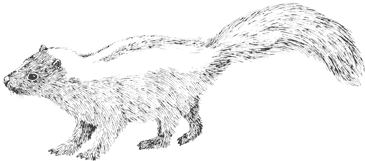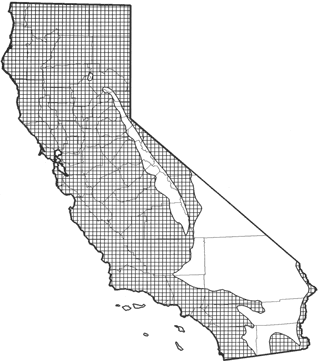
Striped Skunk
Distribution, Abundance, and Seasonality
Common, yearlong resident from sea level to timber line (Grinnell et al. 1937). Found in nearly all habitats, but frequents earlier seral stages of conifer and deciduous forests, and intermediate-canopy stages of brush and shrub areas. Commonly found in grass/forb stages of most habitats, riparian areas, and many natural, and human-induced, herbaceous shrub and forest ecotones. Absent from many xeric areas of the Mojave and Colorado deserts.

Range Map
Specific Habitat Requirements
Feeding: Striped skunks are omnivorous. Primarily eat insects, small mammals, other small vertebrates, eggs, crustaceans, fruits, seeds, and some carrion. Search and dig on ground, in earth, logs, and stumps for food (Wade-Smith and Verts 1982).
Cover: Use cavities and crevices in rock areas, snags, logs, stumps, under buildings, and use abandoned burrows for cover. Excavate burrows in friable, well-drained soils, and also may den above ground in heavy cover.
Reproduction: Den in burrows and cavities described above used for reproduction.
Water: Probably require drinking water.
Pattern: Good habitat includes a complex mosaic of brush stages of forest habitats, riparian areas, meadows, or other open areas in brush and forest habitats. Use edges between types extensively.
Species Life History
Activity Patterns: Mostly nocturnal; some crepuscular activity. May remain in den during periods of inclement weather.
Seasonal Movements / Migration: Non-migratory.
Home Range: In Illinois, summer home ranges of 4 individuals varied from 34-753 ha (83-1860 ac). Winter movements were restricted to a small area near the central den in areas with winter snow (Storm 1972). Average length-to-width ratio of home ranges was about 3:1. Several females, or a male and 1, or more, females, frequently shared a winter den. Females moved about freely within the home ranges of several males (Storm 1972).
Territory: In captivity, adult males and pregnant, or lactating, females must be housed separately. In eastern Oregon, Thomas (1979) reported territories of 17-38 ha (43-95 ac). The minimum area required for a population of striped skunks was estimated to be about 259 ha (640 ac) by Thomas (1979).
Reproduction: Breed from late January through March (Verts 1967). Gestation period about 63 days average (range = 59-77 days). One litter of about 4 (range= 2-10) born April through June (Verts 1967, Maser et al. 1981). Young weaned at 60-75 days. Both males and females mature sexually at 10 mo (Wade-Smith and Verts 1982).
Niche: Great horned owls, mountain lions, eagles, coyotes, badgers, foxes, and bobcats are known to prey upon striped skunks. Eat large numbers of insects and rodents. An important carrier of rabies; also carry leptospirosis and tularemia. Logging, agriculture, and urban developments that create open areas, fragmented habitats, and mosaics of vegetation may improve habitat for striped skunks, allowing them to expand their range.
Sources & References
California Department of Fish and Game, 1999.
California's Wildlife, Sacramento, CA.
Written by: G. Ahlborn, reviewed by: M. White, edited by: M. White, G. Ahlborn
Bailey, T. N. 1971. Biology of striped skunks on a southwestern Lake Erie marsh. Amer. Midl. Nat. 85:196-207. Grinnell, J., J. S. Dixon, and J. M. Linsdale. 1937. Fur-bearing mammals of California. 2 Vols. Univ. California Press, Berkeley. 777pp. Jackson, H. H. T. 1961. Mammals of Wisconsin. Univ. Wisconsin Press, Madison. 504pp. Maser, C., B. R. Mate, J. F. Franklin, and C. T. Dyrness. 1981. Natural history of Oregon coast mammals. Pac. Northwest For. And Range Exp. Sta., USDA, For. Serv., Gen. Tech. Rep., PNW-133. 496pp. Storm, G. L. 1972. Daytime retreats and movements of skunks on farmlands in Illinois. J. Wildl. Manage. 36:31-45. Thomas, J. W., ed. 1979. Wildlife habitats in managed forests: the Blue Mountains of Oregon and Washington. USDA, For. Serv., Agric. Handb. No. 553. 512pp. Verts, B. J. 1967. The biology of the striped skunk. Univ. Illinois Press, Urbana. 218pp. Wade-Smith, J., and M. E. Richmond. 1975. Care, management and biology of captive striped skunks (Mephitis mephitis). Lab. Animal Sci. 25:575-584. Wade-Smith, J., and B. J. Verts. 1982. Mephitis mephitis. Mammal. Species No. 173. 7pp.
California Animal Facts | California's Wildlife